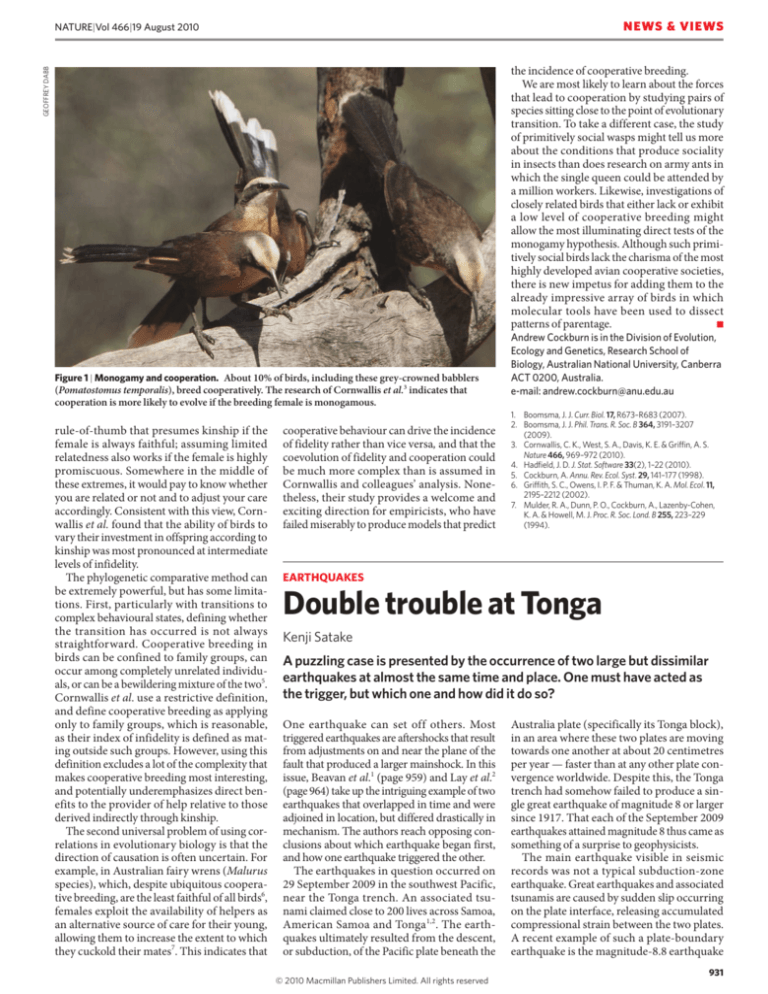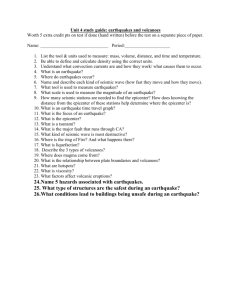
NEWS & VIEWS
NATURE|Vol 466|19 August 2010
gEoFFREY DaBB
the incidence of cooperative breeding.
We are most likely to learn about the forces
that lead to cooperation by studying pairs of
species sitting close to the point of evolutionary
transition. To take a different case, the study
of primitively social wasps might tell us more
about the conditions that produce sociality
in insects than does research on army ants in
which the single queen could be attended by
a million workers. Likewise, investigations of
closely related birds that either lack or exhibit
a low level of cooperative breeding might
allow the most illuminating direct tests of the
monogamy hypothesis. Although such primitively social birds lack the charisma of the most
highly developed avian cooperative societies,
there is new impetus for adding them to the
already impressive array of birds in which
molecular tools have been used to dissect
patterns of parentage.
■
Figure 1 | monogamy and cooperation. About 10% of birds, including these grey-crowned babblers
(Pomatostomus temporalis), breed cooperatively. The research of Cornwallis et al.3 indicates that
cooperation is more likely to evolve if the breeding female is monogamous.
rule-of-thumb that presumes kinship if the
female is always faithful; assuming limited
relatedness also works if the female is highly
promiscuous. Somewhere in the middle of
these extremes, it would pay to know whether
you are related or not and to adjust your care
accordingly. Consistent with this view, Cornwallis et al. found that the ability of birds to
vary their investment in offspring according to
kinship was most pronounced at intermediate
levels of infidelity.
The phylogenetic comparative method can
be extremely powerful, but has some limitations. First, particularly with transitions to
complex behavioural states, defining whether
the transition has occurred is not always
straightforward. Cooperative breeding in
birds can be confined to family groups, can
occur among completely unrelated individuals, or can be a bewildering mixture of the two5.
Cornwallis et al. use a restrictive definition,
and define cooperative breeding as applying
only to family groups, which is reasonable,
as their index of infidelity is defined as mating outside such groups. However, using this
definition excludes a lot of the complexity that
makes cooperative breeding most interesting,
and potentially underemphasizes direct benefits to the provider of help relative to those
derived indirectly through kinship.
The second universal problem of using correlations in evolutionary biology is that the
direction of causation is often uncertain. For
example, in Australian fairy wrens (Malurus
species), which, despite ubiquitous cooperative breeding, are the least faithful of all birds6,
females exploit the availability of helpers as
an alternative source of care for their young,
allowing them to increase the extent to which
they cuckold their mates7. This indicates that
cooperative behaviour can drive the incidence
of fidelity rather than vice versa, and that the
coevolution of fidelity and cooperation could
be much more complex than is assumed in
Cornwallis and colleagues’ analysis. Nonetheless, their study provides a welcome and
exciting direction for empiricists, who have
failed miserably to produce models that predict
Andrew Cockburn is in the Division of Evolution,
Ecology and Genetics, Research School of
Biology, Australian National University, Canberra
ACT 0200, Australia.
e-mail: andrew.cockburn@anu.edu.au
1. Boomsma, J. J. Curr. Biol. 17, R673–R683 (2007).
2. Boomsma, J. J. Phil. Trans. R. Soc. B 364, 3191–3207
(2009).
3. Cornwallis, C. K., West, s. a., Davis, K. E. & griffin, a. s.
Nature 466, 969–972 (2010).
4. Hadfield, J. D. J. Stat. Software 33(2), 1–22 (2010).
5. Cockburn, a. Annu. Rev. Ecol. Syst. 29, 141–177 (1998).
6. griffith, s. C., owens, i. P. F. & Thuman, K. a. Mol. Ecol. 11,
2195–2212 (2002).
7. mulder, R. a., Dunn, P. o., Cockburn, a., Lazenby-Cohen,
K. a. & Howell, m. J. Proc. R. Soc. Lond. B 255, 223–229
(1994).
eArthQUAKes
Double trouble at tonga
Kenji satake
A puzzling case is presented by the occurrence of two large but dissimilar
earthquakes at almost the same time and place. One must have acted as
the trigger, but which one and how did it do so?
One earthquake can set off others. Most
triggered earthquakes are aftershocks that result
from adjustments on and near the plane of the
fault that produced a larger mainshock. In this
issue, Beavan et al.1 (page 959) and Lay et al.2
(page 964) take up the intriguing example of two
earthquakes that overlapped in time and were
adjoined in location, but differed drastically in
mechanism. The authors reach opposing conclusions about which earthquake began first,
and how one earthquake triggered the other.
The earthquakes in question occurred on
29 September 2009 in the southwest Pacific,
near the Tonga trench. An associated tsunami claimed close to 200 lives across Samoa,
American Samoa and Tonga1,2. The earthquakes ultimately resulted from the descent,
or subduction, of the Pacific plate beneath the
© 2010 Macmillan Publishers Limited. All rights reserved
Australia plate (specifically its Tonga block),
in an area where these two plates are moving
towards one another at about 20 centimetres
per year — faster than at any other plate convergence worldwide. Despite this, the Tonga
trench had somehow failed to produce a single great earthquake of magnitude 8 or larger
since 1917. That each of the September 2009
earthquakes attained magnitude 8 thus came as
something of a surprise to geophysicists.
The main earthquake visible in seismic
records was not a typical subduction-zone
earthquake. Great earthquakes and associated
tsunamis are caused by sudden slip occurring
on the plate interface, releasing accumulated
compressional strain between the two plates.
A recent example of such a plate-boundary
earthquake is the magnitude-8.8 earthquake
931
NEWS & VIEWS
a
NATURE|Vol 466|19 August 2010
Beavan et al.1
Slip rate
B2
B1
Time
B1 is slow and not detected
by seismic data
Observed seismograms
Ground displacement
L2 buried in seismic data
Lay et al.2
L2
L1
Slip rate
Time
b
Tonga
Samoa
Displacement detected by GPS
Tsunami sources
Australian plate
(Tonga block)
L2
B1
Trench Outer rise
B2
L1
Pacific plate
Pull force
Figure 1 | interpretations of the two tonga-trench earthquakes of 29 september 2009. a, Beavan
et al.1 (B) and Lay et al.2 (L) come to different conclusions about the order in which the earthquakes
happened. B1 and L1 denote which, respectively, the authors consider to have occurred first. But
seismologically, neither interpretation is clear-cut: if an earthquake is slow and the slip rate is
small (B1), the signal may be undetected in regular seismic records. Alternatively, if the second
earthquake (L2) happens soon after the first one, the signal can be buried in seismic records.
b, Depiction of the Tonga trench, where the Australian and Pacific plates meet. The two groups1,2
agree that B1/L2 was an interplate earthquake, due to compressional stress, at the boundary
between the plates; and that the main, visible, earthquake (B2/L1) was an intraplate event that
occurred at the outer rise due to extensional stress. Beavan et al.1 drew their conclusions from
GPS measurements and models of tsunami waveforms. Lay and colleagues’ interpretation rests on
analyses of the available seismic data.
that rattled central Chile and set off a tsunami
on 27 February 2010. By contrast, the main
Tonga event resulted from extensional faulting that occurred in an area known as the outer
rise, where the descending plate begins to bend
into the trench.
Still, it is not a geophysical surprise to find a
great outer-rise earthquake. Several have been
recorded during the past 100 years, and they
are easily explained by downward pull by the
descending plate. This pull force can be transmitted towards the outer rise if the two plates
do not accumulate strain on the plate-boundary fault, and it can also increase suddenly if the
plate boundary breaks in a great earthquake. A
November 2006 plate-boundary earthquake of
magnitude 8.3 along the Kuril trench set off
an extensional outer-rise earthquake of magnitude 8.1 just two months later3, by causing the
subducting plate to pull away from the outer
rise. In a generic case, such triggering results
from a change in static stress. Sudden displacement on a fault during an earthquake adds to
932
the load on some neighbouring faults and
subtracts from the load on others. These stress
changes may hasten or retard earthquakes,
respectively4.
In the Tonga case, both Beavan et al.1 and Lay
et al.2 found that a plate-boundary earthquake
was associated with the outer-rise earthquake
(Fig. 1). The strongest evidence for this finding comes from satellite geodesy. By comparing
pre- and post-earthquake measurements from
northern Tonga, made by the Global Positioning System (GPS), Beavan et al.1 estimate that
35 cm of horizontal movement occurred in
a direction opposite to that expected for an
outer-rise earthquake. Continuous GPS measurements, such as those made during the 2010
Chilean earthquake, were not available, however; such measurements could have pinpointed
which earthquake happened first.
Clues to the earthquakes’ sequence can also
be found in tsunami waveforms recorded on
bottom-pressure (DART) sensors operated
by the US National Oceanic and Atmospheric
© 2010 Macmillan Publishers Limited. All rights reserved
Administration (NOAA). These waveforms
are sensitive to the parent earthquake because
plate-boundary earthquakes and outer-rise
earthquakes produce opposite sea-surface displacement above the earthquake fault. NOAA
modellers implicitly assumed a plate-boundary
earthquake model in their successful real-time
data assimilation to forecast the far-field tsunami5. Beavan et al. likewise show that the
tsunami waveforms recorded at the DART stations are better explained by a plate-interface
earthquake, and they obtained the best match
by postulating the occurrence of a slow plateboundary earthquake before the outer-rise
earthquake. They point out that this sequence
can be explained by static stress change, as in
the Kuril example.
When two earthquakes occur nearly simultaneously, the signal from the later event may
be buried in the seismic waves from the first.
Lay et al.2 carried out non-routine, detailed and
comprehensive analyses of the available seismic data, and succeeded in detecting signals
from earthquakes after the outer-rise earthquake. Their model indicates that the main
outer-rise earthquake triggered the rupture of
the plate boundary by shaking it. Such dynamic
triggering is plausible: it has been documented
on faults hundreds of kilometres from the
initiating earthquake6.
But it is still difficult to tell whether the plateinterface earthquake really happened later. If
that event was generated slowly in comparison to seismic-wave periods, it would not have
been detected in ordinary seismic records1.
Analysis of ultra-long-period seismograms2
can indicate the existence of such slow earthquakes, but it is difficult to achieve an accurate
estimate of timing from such ultra-long-period
records. Lay et al.2 locate the plate-boundary
earthquake (as a pair of subevents) close to the
trench. It has been shown that the shallower
on the plate interface and closer to the trench
axis slip occurs, the slower it is7. Therefore,
the plate-boundary earthquake rupture might
have been slow.
Taken together, the two papers 1,2 leave
uncertainty as to which of the two earthquakes happened first. And, until we learn
which of them was the cause and which the
effect, it will be difficult to know whether the
trigger was the release of static stress on an
extensional fault, or of dynamic stress on a
compressional one.
■
Kenji Satake is at the Earthquake Research
Institute, University of Tokyo, Bunkyo-ku,
Tokyo 113-0032, Japan.
e-mail: satake@eri.u-tokyo.ac.jp
1. Beavan, J. et al. Nature 466, 959–963 (2010).
2. Lay, T. et al. Nature 466, 964–968 (2010).
3. ammon, C. J., Kanamori, H. & Lay, T. Nature 451, 561–565
(2008).
4. stein, R. s., King, g. C. P. & Lin, J. Science 265, 1432–1435
(1994).
5. http://nctr.pmel.noaa.gov/samoa20090929
6. gomberg, J., Reasenberg, P. a., Bodin, P. & Harris, R. a.
Nature 411, 462–466 (2001).
7. Bilek, s. L. & Lay, T. Nature 400, 443–446 (1999).










